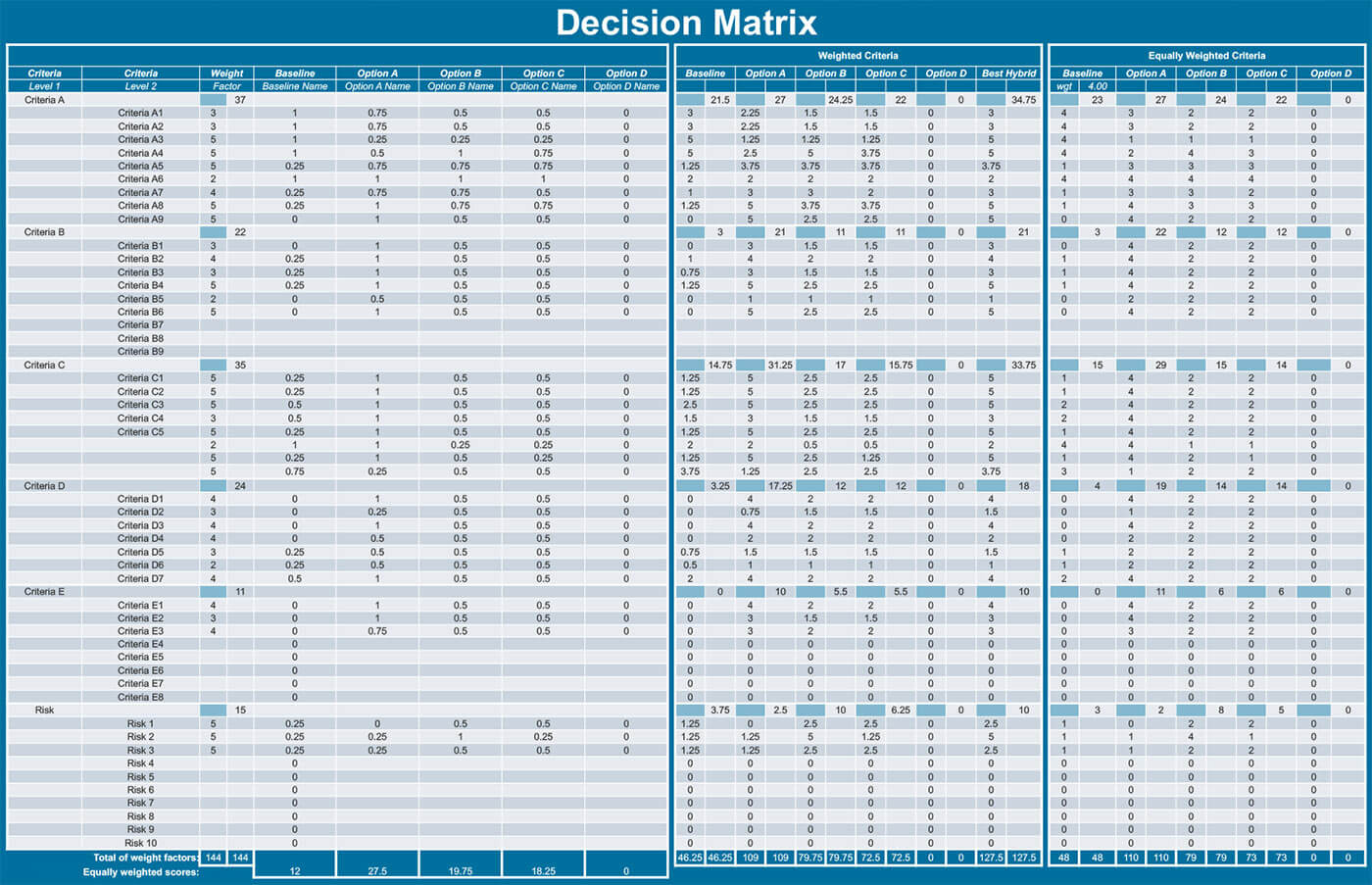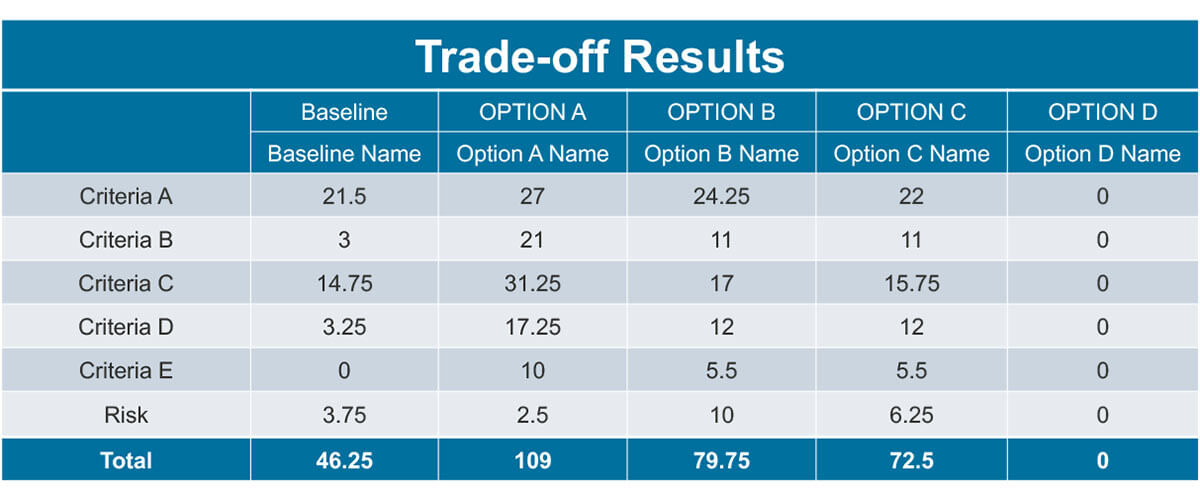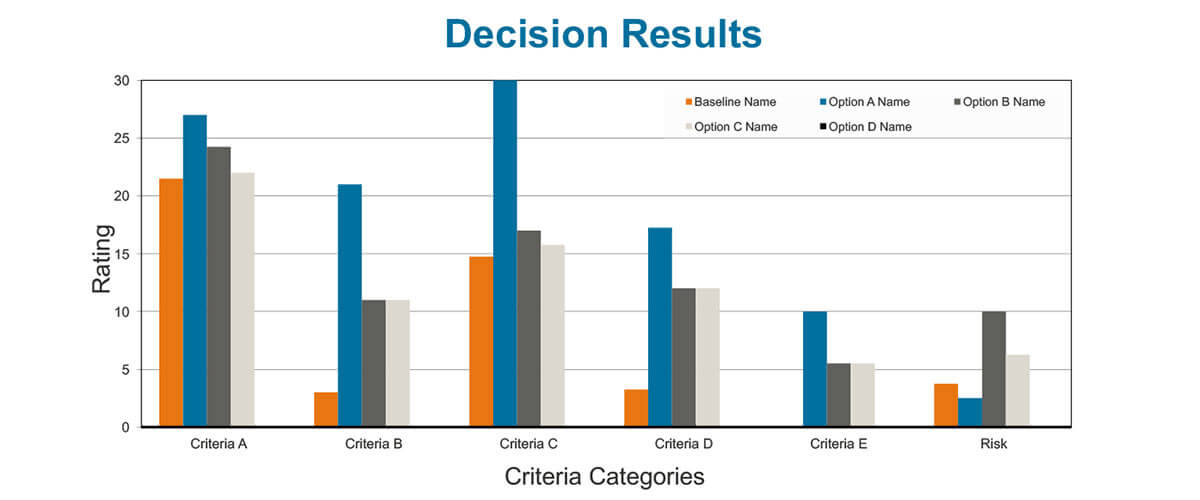
Don’t Settle for Second Best
After a design choice has been made, have you ever had the sinking feeling that you inadvertently settled for second best? The process can be frustrating. It always seems to take more time to piece together a complete and total list of boundary conditions and evaluate them properly before making a selection. I’ve often heard it said, “The good is always the enemy of the great.” So, how do we make design choices with a greater assurance that it is in fact the resounding and equivocal best option? Let’s look at some common barriers and an excellent booster (called a Weighted Decision Matrix) for effective and efficient decision making.
BARRIERS to Decision Making:






Whew, so you’ve cleared the hurdles— now what do you do with the information gathered? A Weighted Decision Matrix, I’ve found, is an excellent choice (pun intended) to cut through the bias and put the best choice within easy reach.
BOOSTER – The Weighted Decision Matrix for Decision Making:

Below are the steps I take while using this method of decision making. If you have a tool that you employ, please share it with me— I’m always looking to improve.
1. Define the Desired Outcome of the Weighted Decision Matrix. Begin with the desired end in mind. Create a clear problem statement upfront to guide you in your next steps.
2. Establish Two Levels of Evaluation Criteria. Set criteria based upon customer or business interests, these are Critical to Quality areas (CTQs). Level 1 is usually fixed for a given stage in a product development while level 2 varies depending on the particular Weighted Decision Matrix topic.
3. Establish Criteria Weighting and Measurement. Start with the default of equal weighting and then consider each item independently. Begin with Level 2 and then consider the Level 1 overall score while the remaining Level 2 criteria is developed. If you get completely stuck in deciding or agreeing on weights, I have used Binary Comparison Analytic Hierarchy Process (AHP) with success.
4. Determine How Alternatives Will be Evaluated. A quantitative method is best but there are many times where a qualitative approach is sufficient. Document considerations to help remind you of why a certain decision was made and in what manner if you have need to return to it later.
5. Define Concept Alternatives. Define all potentially viable concepts. Use brainstorming or mind-mapping exercises to get as many ideas on paper as possible and then narrow to the best and most achievable. Allow yourself the ability to have a wild idea. You never know when a team’s wild idea might spur a thought that becomes a very achievable and practical solution. Once the final concepts are defined, get the baseline score established. One note before we move on, if more than four to five alternatives exist— it may be too difficult and time consuming to push that many through a matrix analysis. I’ve found that completing iterative studies reduce the number of alternatives quite effectively. Use a Weighted Decision Matrix with the objective to select the top three or four (not top one) alternatives. The goal is to reduce the number of alternatives in this first Weighted Decision Matrix; the weighting is more easily generated as it has less fidelity. In this first round, complete the matrix just using one level of criteria.
6. Establish the Baseline. Select one alternative to use as the base from which all other alternatives are to be evaluated. Typically, this is the alternative which is best understood. In many cases, I’ve used the current design if it exists. It’s best to keep this fixed for all trades in a project
7. Evaluate Alternatives. Based on the defined criteria, evaluate each alternative and give it a relative score; negative if worse and positive if better than the baseline. When scoring, it is common that evaluation criteria would be updated based on more knowledge of alternatives. The best rule of thumb here is to be consistent for all alternatives. Don’t fall into the trap of allowing intuition to overrule rational thought and skew the matrix in the favor of what your intuition desires. I’m often surprised at an outcome when I don’t let my option prejudice play with the numbers.

8. Review Best Hybrid Alternative Results. This is the theoretical alternative (that may not be practical) which matches the best score of any alternative for each criterion. This is used to help establish the significance of the results in step 9.
9. Analyze the Results. Results are graphed. Establish sensitivity of results to critical uncertainties— such as weighting values and evaluation of certain parameters. This is typically done by completing a rating with everything weighted equally and/or by varying the level 2 weights for some criteria.

Determine the significance of the results based on the confidence of input. The best hybrid is a great indicator of numeric significance between the alternatives. This represents the best of the best.
Determine whether the Weighted Decision Matrix has selected one alternative or has eliminated one or more alternatives. An additional study, which is usually more quantitative and with fewer number of alternatives can then be completed to select one concept.
Sort the level 2 criteria by weight factor to help assess if relative weight factors match relative importance of the criteria. Assess the sum of scores for the various weight factors. It can be illuminating to know, for example, if the most important criteria point to the same option as the lower criteria.
Use the scores for the level 1 criteria to define improved hybrid alternatives. One of the best outcomes of a Weighted Decision Matrix is a better solution.
Don’t settle for second best! Know and navigate around your barriers to productive decision making. Consider your options carefully. Your decision making process makes all the difference between a good decision and a great one!
Written By: Joe Pighetti, Electronics Systems Engineer
With 15 years of aviation systems engineering, product engineering, production support, project/program management (think Boeing 787 Dreamliner), Joe has a ton of knowledge to contribute. He has a Masters in Engineering Management from Western Michigan University, a BS in Electrical Engineering from GVSU, and PMP Certification. In his spare time, Joe enjoys cooking, making music, woodworking, and building a beautiful life with his wife & 3 kids.
Written By:

Joe Pighetti
Electronics Systems Engineer
DISHER Newsletter
Sign up to receive articles and insights, delivered monthly.
Schedule a no-committment project call
Reach out to discuss your project to find out if DISHER could be a good fit for you.
